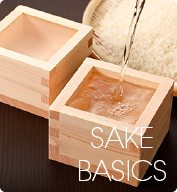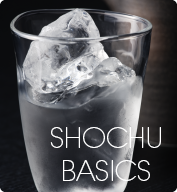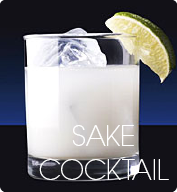WHAT'S SHOCHU?
Shochu is a popular Japanese distilled spirit made of many different ingredients such as barley, sweet potatoes, rice, buckwheat, brown sugar, and among others. This unique distilled spirit production first began in the southern region of Japan around the 15th century and gradually spread all over Japan. In recent years the popularity of Shochu has been revived among Japanese, notably the young generation.
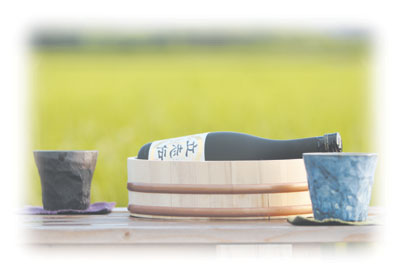
Honkaku Shochu & Kohrui Shochu
There are two kinds of Shochu: "Kohrui Shochu", often called "Japanese vodka", is made by continuous distillation of polysaccharidic materials, and "Otsurui Shochu", also better known as "Honkaku (authentic) Shochu", made by single distillation. The former (Kohrui Shochu and grain whiskey) needs continuous distillation whereas the latter (Otsurui Shochu and malt whiskey) requires pot still.
Honkaku Shochu has three major characteristics:
- The flavor from raw materials remains due to single distillation.
- Made by multiple fermentation in parallel using rice malt.
- Carries a gentle taste and can be drunk straight without aging.
| Kohrui Shochu | Honkaku Shochu | |
| Raw Materials | Syrup/Molasses/Others | Grain/Others |
| Fermentation | Single fermentation | Parallel multiple fermentation |
| Distillation Method |
Continuous distillation | Pot-still, single distillation |
| Percentage of Alcohol |
Less than 36% | Less than 45% |
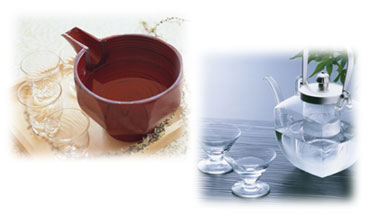
Elements that define taste of Shochu
"Honkaku Shochu" comes in a variety of tastes and flavors (like sake and wines) that originate from the raw ingredients. However, if you understand the following four key elements:
- Raw ingredients
- "Koji kin"
- Distillation methods
- Aging methods
You will grasp the basics of Shochu and figure out your favorite ones even when thousand different kinds are presented. Once you start looking for Shochu by yourself, you will realize the depth of its world.
Click here to see the details of Shochu brewing and distilling process.

1. More than 60 kinds of raw ingredients
More than sixty kinds of raw ingredients are used in the Shochu production. Each adds a distinctive taste to the resultant Shochu. The major ones are wheat, rice, sweet potatoes and dates.
- Wheat: usually Nijo wheat is used to produce a light and easy to drink Shochu.
- Rice: brings out rich taste, soft impact as well as unique sweetness and fragrance. Kuma Shochu and Ryukyu Awamori are famous for using rice in the first production process.
- Sweet Potatoes: provide with distinctive sweetness, sweet aroma, and rich flavor.
- Dates: very sweet fruits grown in the Middle East.
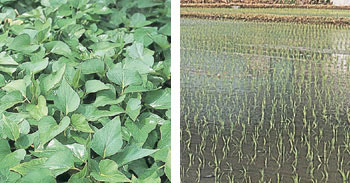
Sweet potato field/Rice paddy
2. Koji Kin (Aspergillus): the key ingredient of Shochu
The unique feature of Japanese Shochu and Sake is the use "Koji" (malted rice) for brewing. Other brewed or distilled alcohol made all over the world uses only yeast. Japanese Shochu, on the other hand, uses "Koji" in addition to yeast.
- Black malt: traditional malt with a long history. It makes Shochu full-bodied and brings out a distinctive, rich taste.
- White malt: standard malt that is widely used. It brings out a light, gentle, crisp taste.
- Yellow malt: another traditional malt used for Sake production. Though it has long been avoided in Shochu production because its use necessitates a complicated heat management, it has been revived lately.
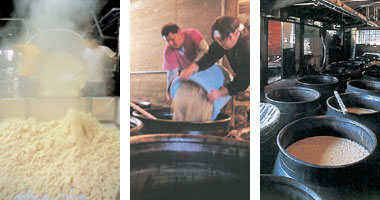
3. Single distillation
Shochu is distilled in two methods: single-distilling and multiple-distilling. Honkaku Shochu is made by single distillation that specifically excludes the extracts at the beginning and the ending of distillation process. There are two kinds of distillation methods. There are two kinds of distillation methods. In addition, pot-still (distillation machines) varies in its materials (ex. wood, stainless, tins), its sizes and forms, depending on distilleries.
- Normal pressure distillation
It is a method in which the pressure inside of distillation machine is not controlled. The resultant taste of the Shochu produced reflects the raw materials due to the high boiling point of alcohol. - Reduced pressure distillation
In this method a low pressure (almost vacuum) is applied inside the distillation machine. It brings out a gentle, light taste and has a soft palatal impact because of its low boiling temperature.
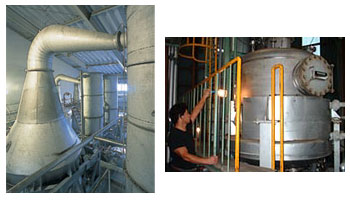
4. Three Ways of Aging Shochu
There are mainly three ways of aging Shochu; aging in barrels, ceramic pots, and tanks.
- Aging in barrel: oak barrels or imported barrels that once contained sherry are used. The barrels add a scent and beautiful amber color.
- Aging in ceramic pot: this is a long aging process that produces a Shochu with no color and a milder taste through the effects of far-infrared radiation and the respiration by the ceramic pots.
- Aging in tank: aging in stainless or enameled iron tanks. Since the container has minimal effects on the Shochu, the distinctive taste from raw materials remains in resultant Shochu.

Barrels
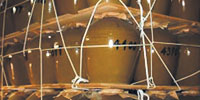
Ceramic Pots

Tanks

